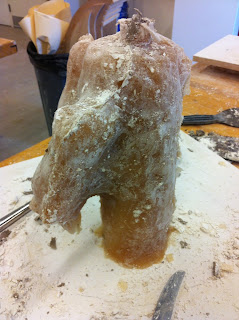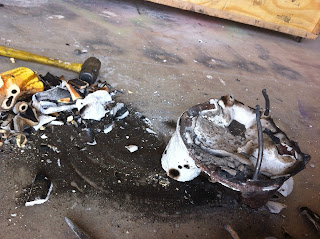 My motto for this project is: "If at first you don't succeed, try, try again." Seriously this is the most challenging bronze piece I have ever attempted, and unfortunately, I was unable to complete it by the end of the semester. However, I plan to complete this piece this fall.
My motto for this project is: "If at first you don't succeed, try, try again." Seriously this is the most challenging bronze piece I have ever attempted, and unfortunately, I was unable to complete it by the end of the semester. However, I plan to complete this piece this fall. I began the project with a large cylinder of clay, approx. 18" tall and 12" in diameter.
I carved the entire piece from this solid mass, creating a womb-like form that is suspended by pillars. The form has an hourglass shape and inside there is the form of a small infant figure that presses against the walls of the womb. As the figure hangs suspended in the air, it appears to transform into sand-conveying the feeling that time is running out for the baby. This is a very personal piece for me that conveys my inner conflict with change in my life, in that there are still so many things that I want to accomplish in life, however, if I want to have children, time is running out and I must act in a timely manner.
In order to cast this piece in bronze, it first had to be dissected into 4 different pieces. This was VERY SCARY for me, as I had just spent an extreme amount of time carving this piece.
 A blanket mold was made for each piece by rolling out a 1/2" slab of clay and wrapping each of the pieces in plastic wrap before covering them with a layer of clay.
A blanket mold was made for each piece by rolling out a 1/2" slab of clay and wrapping each of the pieces in plastic wrap before covering them with a layer of clay.Then, each piece is covered with a layer of plaster to create a plaster mold. This was not fun for me, as I absolutely HATE working with plaster. This process takes several hours, and as I was on a tight deadline, I pulled an all-nighter making the plaster molds.
To add to the situation, all of my plaster molds crumbled to pieces the following day. After some tears and an encouraging pep talk from a classmate, I proceeded to remake my plaster molds.
Another injury. I'm not sure how I even did this one...
After the molds were completed and dry, the pieces were taken out of the molds and the blankets of clay over the original clay pieces I carved were discarded.
 Next, the molds are placed back together tightly and liquid rubber is poured into each of the molds.
Next, the molds are placed back together tightly and liquid rubber is poured into each of the molds.After the rubber is set, the molds are taken apart again and the master pieces (the original pieces I carved) are discarded.
Now, we are left with rubber molds with which we can pour our wax into.
Casting wax is poured into each of the molds in a series of thin coats until a 1/4" thick coat of wax is inside each of the molds.
Next, a sprue system is planned to sprue each of the pieces to be cast. To the left is classmate Anna helping me determine how to sprue these pieces.
Next, each of the pieces are checked to make sure that there aren't any thin spots that are less than 1/4" thick. More wax is brushed or dripped on if needed.
After the wax pieces are sprued, they are covered in a series of coats of slurry and silica, creating a ceramic shell.
Next comes the bronze pour!!!
It was not a successful pour. The first two pieces poured turned out good, but the third shell broke during the pour and took the rest of the bronze with it.
I really feel that this piece will be well worth the effort once completed. I hope to conclude this project next semester.





























No comments:
Post a Comment